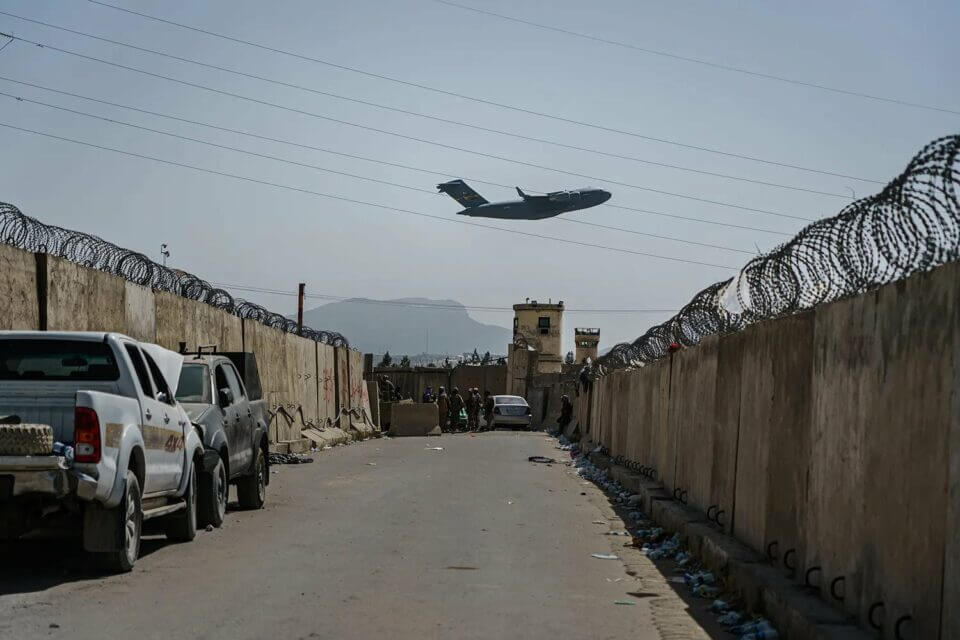
“The stated North Atlantic Treaty Organization (NATO) objective in Afghanistan was nation-building, but what was created instead, over 20 years, and fell in days, was a heavily garrisoned foreign aid bazaar.”
Over the course of this year, the Taliban has been further imposing its ideology on the people of the Islamic Emirate of Afghanistan, disadvantaging in particular female education and development. Poor governance in 2022 was responsible for extreme hunger and a severe banking contraction. Following the collapse of the Western-backed Kabul government in 2021, the United States froze $9.5 billion in Afghan central bank assets. Following talks between the Taliban and the international community in Oslo, Norway on January 24, 2022, there was an attempt to make foreign aid to the Taliban government contingent on human rights markers, as well as requiring the Afghan government to be more representative of religious minorities and women. The United Nations (UN) declared that it needed $623 million for aid to Afghan refugees residing in neighboring states, along with $4.4 billion in aid for Afghanistan proper. The United States pledged $308 million for humanitarian aid to Afghanistan and $474 million to Afghan refugees.
This desperate demand for foreign aid is all very familiar. This is, in part, a consequence of the foreign aid community’s fixation on Afghanistan, a country that objectively is better off than certain war-torn countries that are actually more deserving of international assistance. Scarce foreign aid funds should be disbursed where they are most needed and are most effective—and should not flow disproportionately to groups fixated on providing resources to a particular nation. In Afghanistan, in particular, the allocation of scarce foreign aid funds should be measured against past successes. While 20 years of foreign aid has not significantly increased literacy in Afghanistan, it has reduced child mortality by more than half.
Western taxpayers were largely deceived about the effectiveness and sustainability of foreign assistance in Afghanistan during the 20 years following 2001. The stated North Atlantic Treaty Organization (NATO) objective in Afghanistan was nation-building, but what was created instead, over 20 years, and fell in days, was a heavily garrisoned foreign aid bazaar. The current debate about what to do about Afghanistan is largely fueled from the same professional aid-management community, though their policies never served the NATO members’ public interest. The decisive indicator of unsustainability, improved at first, and then stagnant for 20 years, was that only half of Afghanistan’s budget revenue came in from tax arrangements. The remainder was the result of overseas grants and loans.
It is not true that the Afghans had never built a state structure able to balance revenue and disbursements while developing their society. Then, as now, the goal was to create robust institutions to enable Afghanistan to adjust to foreign powers, then the Mughal, Khalistani, Persian, Russian, and English. The regime of Amir Sher founded the Afghan civil service and introduced modern education, as the basis of imposing urban rule over rural areas, as it was no longer possible to raise revenue through extortion raids of neighbors. Running afoul of the English Empire, he was summarily defeated in 1878. His successor, Abdur Rahman Khan, successfully raised revenue by taxing trade, reformed the laws, introduced conscription, and actually decided that the largely illiterate Pakhtunwali-abiding Afghans would be Sunni rather than Shia, a fairly profound act of recent social engineering given influences from Persia. These civil service accomplishments were subsequently dismantled in the next two regimes through sponsored revolts by the British, but they do demonstrate realistic expectations for Afghanistan.
The origin of the problem is that once the American denial of sanctuary operation against the Taliban was complete, Afghan policy was transferred by politicians to the development community, which is composed of a trinity of co-dependent players: the well-intentioned left-leaning social reformers, the professional foreign aid contractors, and the array of indigenous Afghan partners who have come to depend on foreign aid. The program was directed far more like the Marshall Plan, focused on the familiar routine of aid disbursement, than like the American occupation of Japan under General Douglas MacArthur, which was more focused on socio-political engineering.
First, let us turn our attention to the social reformers. In the university where I teach, it would be a conservative estimate that the number of students intent on international developments studies and human rights in international relations outnumber those focused on traditional security by ten-to-one. It is a decades-long cursus honorum of unpaid internships at non-governmental organization, dangerous postings, fundraising, and, if finally engaged by the UN, an endless series of insecure twelve-month contracts. Their cause célèbre is the education of girls, which is associated with a great many socially-engineered benefits from reducing birth rates and improving child care to increasing social productivity.
But this effort has proven to be a catastrophically provocative initiative to the rural Afghan population. The first problem is that widespread education of girls cuts into the wealth of a family (since one pays for girls with dowries in pastoral societies, given that they are productive herders). Plus once a girl is educated, she is beyond the reach of a society of arranged within-cousin group marriages, which is a manner of keeping property within an extended family. It is likely that every single rural girl’s school built by the Canadian effort outside Kandahar has ended in closure, demolition, or repurpose, though it is difficult to tell since the Canadian government has been careful never to reveal whether it knows this for a fact.
Social reforms can have strategic payoffs, but there are circumstances in which they become prohibitively expensive or impossible, especially with a weak government in Kabul. There are parallels in the 1857 Indian uprising against the British; however, contrary to popular belief, the main issue was not the pork and cow lubricant on the Sepoys’ cartridges. Rather, Levellers, Quaker-like religiously motivated social reformers, and others, had come to dominate departments of the British East India Company. These activist Christians sought land redistribution in a culture in which most common Hindu and Muslim soldiers were actually the youngest sons of the landed elite rather than drawn from the poor. Military service was, in fact, lucrative and the abode of the elite, as it remains today for Pakistan’s officer corps recruited from the Salt Range of the Punjab. Once the mutiny was suppressed, the British canceled the East India monopoly and purged its civil service of reformers. Land reform would wait until much later, when it was feasible.
The second of the trinity are the professional foreign aid contractors, masters of their donor-aid networks, typically technical experts in engineering, who rotate through lucrative contracts with their own Western governments, the indigenous Afghans seeking access to their funds, and international organizations. These are often the liaisons between Western aid agencies and ministries. They garner great salaries, and their principal impact is as the influencers of the type of civil service development in foreign capitals, as well as skyrocketing local rents.
Between the naively sincere social reformers and the predatory professional contractors sits the political elite in Kabul. The civil service that had evolved in Kabul was a revolving bidding station designed to access foreign aid contracts through these gatekeepers. Raising revenue locally was completely disincentivized in lieu of targeting the lucrative foreign aid market. I am more familiar with the Pakistani situation, a problem seven times as large, which fills the many doctoral dissertations I have reviewed from the University of Punjab at Lahore over the past decade. The nexus is well audited, though I can think of a number of instances of opaque public-private racketeering. I was unwisely invited to a Canadian foreign ministry conference on foreign aid to Afghanistan, with many of the key aforementioned stakeholders, spoke my mind, and was never invited back. It was not the first time I had attended a conference on Afghanistan to point out the uncomfortable error, in not inviting Pakistani interests. There were concerns that Pakistan would seek to shave some of the transfers, or worse, block them, as it dominated most of the transit points. For millennia, 90% of Afghanistan’s trade has traditionally been through Pakistan to India. Afghan access to India became blockaded during a border conflict with Pakistan in 1947 and persisted until 1963, reorienting Afghanistan’s economy and foreign aid sources toward the Soviet Union. Today, the United States and the European Union have provided Pakistan a selective free trade agreement to their markets, as a quid pro quo for permitting Afghan transit trade to India. Regardless, Pakistan dominates the supply of construction materials to Afghanistan that is purchased by foreign aid to Kabul, as well market control of sectors of Afghanistan’s economy, for example, the carpet weaving industry.
Afghanistan has been lost politically, though it may be possible to salvage local foreign aid projects. There are, however, innumerable ongoing nation-building campaigns across the globe that would benefit from the insights garnered from this disaster. The scale of the aid expenditure (and subsequent state collapse in Kabul) demonstrates, first, that the 2005 Paris Declaration largely misdiagnosed the foreign aid problem as being one of an imbalance between donors and recipients, when it is actually one of collusion. Second, it is unwise to rely on military force to enable giving preference to popular—but locally provocative—social reform projects.
Julian Spencer-Churchill is an associate professor of international relations at Concordia University, author of Militarization and War (2007), and of Strategic Nuclear Sharing (2014), and former Operations Officer, 3 Field Engineer Regiment. He has published extensively on Pakistan, where he conducted fieldwork for over ten years, as well as in Bangladesh, India, Indonesia and Egypt.











